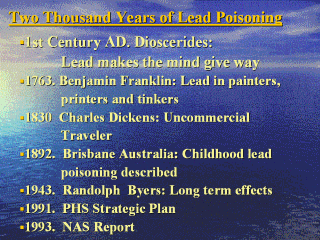 |
Some landmarks in
our knowledge of lead poisoning over 2 millenia.
- Dioscerides, physician to Nero and
surgeon in the Roman army, wrote that Lead makes the mind give way. In the
18th century, Benjamin Franklin, in a letter to his publisher,
Benjamin Vaughan, graphically described the colic and wrist drop that
afflicted tinkers, painters and printers.
- In the 19th century Charles
Dickens described a visit to a lead mill outside of London, and
encountering a gravely ill woman who had worked there.
- Until 1892, when J. Lockhart Gibson, in
Brisbane Australia, described lead poisoning in children, the toxin was
thought to damage only miners and wine drinkers.
- After Gibsons report, it was believed
that if a child became lead poisoned, he or she either died or recovered
without any trace of the illness. In 1943 Randolph Byers reported that of
20 recovered child victims of lead poisoning, 19 had behavior disorders,
school failure or were mentally impaired.
- It was then believed that sequellae of
childhood lead poisoning was found only in children who had suffered
clinical encephalopathy.
- In 1991 the CDC issued A Strategic Plan
for the Elimination of Childhood Lead Exposure, a historic document
calling for true primary prevention by eliminating lead from the
environment before it entered the bodies of children
- The evidence of cognitive deficits in
children who had asymptomatic elevations of lead exposure was strong
enough that the NAS report concluded that lead toxicity was found in
children with lead levels of 10µg/dl,
or perhaps lower.
|
